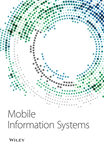[Retracted] The English Teaching Mode under the Environment of Computer Technology
Abstract
The development of Internet information technology has opened up new potential for the education sector, encouraging the development of innovative teaching and learning methods as well as the optimal use of available educational resources. In this environment, the online plus offline mixed teaching model emerged, which can not only get around time and space restrictions and link smoothly inside and outside the classroom but also enhance the form of teaching and learning and strengthen teacher-student relationships. However, to assure the quality of instruction, this research first examines the successful ways of developing an online plus offline hybrid teaching mode from the perspective of college English professors. Second, in this paper, the support vector machine and particle swarm method are used to build an evaluation model of the English teaching effect. The model has the potential to increase the accuracy and efficiency of English teaching impact evaluation while also meeting the standards of English teaching effect evaluation. The experimental findings show that, while evaluating the effects of college English instruction, the technique beats the comparison algorithm in terms of evaluation accuracy and algorithm time consumption.
1. Introduction
Artificial intelligence, cloud computing, monitoring and prediction, and zero-knowledge proofs are examples of information technology advancements. Online and offline hybrid Internet-based teaching modes primarily refer to the mode of teaching activities on the network platform and in the classroom. As a result, it is a logical progression from traditional classroom instruction, which calls for open dialogue between students and instructors as well as active participation in class debates as a means of transferring knowledge [1, 2]. Regular (synchronous) instruction takes place offline with the teacher and all students present in the same space at the same time (also known as face-to-face, on-site, and campus teaching.) Online instruction is delivered entirely online utilizing a video platform like Zoom, Microsoft Teams, or Kaltura Live Room. With hybrid instruction, instruction is delivered on campus to a physical class while an online class watches via a video tool. When it comes to teaching college English, the use of online and offline mixed teaching methods is the best way to integrate tradition and modernity, fully demonstrate students’ dominant position, enable them to form a good academic quality in participation and exploration, and contribute to the improvement of English teaching quality [3–5].
In addition to offering face-to-face instruction and online support, hybrid teaching methods that mix offline systematic instruction with online specialized training and online fragmented coaching can successfully connect students within and outside of the classroom. When students participate in a range of activities, they learn more. Students can make use of MOOCs, micro-courses, and other online learning possibilities at this time, or they can do it on their terms. Teachers can aid and guide students in real time online, allowing for more diversified and adaptable online learning. The authors in literature [6–10] proposed the method of gradually improving teaching quality. Teaching online and offline at the same time necessitates the use of big data technology by teachers to monitor students’ progress and accurately record how well they perform in various learning links and grasp their mastery of each piece of knowledge. Provide clear instructions and control teaching accordingly, tally students’ attendance by checking in and punching into the system, and require them to input various learning data online, including the use of mind maps to sort knowledge and the outcomes of assignments they have accomplished [11–13]. Professors can use objective and detailed evaluation to urge students to always improve themselves.
In the past, students had little opportunity to learn supplemental information, such as textbooks and workbooks, due to a limited amount of teaching time [14]. Combining online and offline teaching approaches can assist in integrating resources and providing learners with a variety of high-quality online resources, such as educational films and software, to help them understand the topic being taught in the classroom. As they continue to study and grow, they can improve themselves as educators by employing a variety of tools to lay a firm foundation of academic literacy, which in turn helps students learn more effectively while also boosting classroom standards [15, 16]. Given that each student is unique, teachers who utilize the same teaching technique with each of their courses risk stunting their students’ progress and failing to meet their individual learning needs. It is feasible to increase the relevance of teaching activities at this time by employing an online plus offline hybrid teaching mode, in which teachers can adjust learning objectives and tasks for students based on data analysis findings and students’ daily performance [17–20]. Consolidate the foundation, break through the self, and establish a good learning ability for long-term study and accumulation, as well as contribute to general quality improvement.
Some college English teachers are still significantly influenced by outdated educational ideals, and the teaching methods they use are generally traditional and narrow-minded [21]. As a result, students are never inspired to participate in the actual learning process and are unwilling to collaborate with their lecturers to research and examine the content. Students’ talents and reading levels are also biased one way or the other. Using the same teaching method repeatedly limits pupils’ personal development and hampers their ability to learn, resulting in a lack of progress in their education. The outcome was not what we had hoped for. The effectiveness of college English teaching is currently being examined as an important research topic in college education evaluation. Teachers can change their plans and progress depending on real-time feedback from students using real-time evaluation data. Schools use evaluation outcomes to assess English instructors’ complete teaching abilities, and a scientific and acceptable evaluation process helps to achieve this goal. The study found that assessing the efficiency of college English education is laden with difficulties. For example, the original evaluation procedure places an overwhelming focus on the evaluator’s competence. When personal prejudices of an evaluation subject are considered, outcomes can be unfairly impacted. To assess the efficiency of collegiate English instruction, quantitative measurements must be used.
Hybrid teaching is distinct from blended learning. In a blended learning environment, students get ready for the class using online resources at their own pace (referred to as asynchronous). Instead of using traditional lectures, classes engage with the syllabus through a variety of active work modalities. Combining online and hybrid instruction is possible. Traditionally, the effectiveness of college English education has been assessed using a relatively limited set of criteria. For example, in the instance of the BP neural network for evaluating college teaching quality, researchers studied and modified the model [22–24]. There is an issue with the accuracy of effect evaluation. Gray target choice categories have been investigated by researchers as a means of weighting teaching evaluations [25, 26]. The efficiency of college English teaching effect evaluation is low due to the intricate calculating process of this method [27, 28].
When a big number of people from all over the world collaborate to share and transmit data, this is referred to as particle swarm optimization. Each particle searches for the population’s global and individual extremes during each iteration to update its position and velocity [29–33]. The least squares support vector machine (LSSVM) is an SVM extension that speeds up the solution process by reducing the number of parameters that must be chosen [34, 35]. Because the evaluation of college English teaching effectiveness using particle swarm and SVM algorithms is the emphasis of this research, it is thoroughly investigated in this paper. To avoid the influence of subjective thinking and random factors, this method assesses the impact of college English education on students objectively and scientifically.
The rest of the paper is organized as follows: Section 2 gives teaching strategies in computer environment, Section 3 gives the proposed method, Section 4 gives the results, and the conclusion is given in Section 5.
2. Teaching Strategies in Computer Environment
The first step is to put flipped classroom instruction into action. Flipping the classroom is a sort of blended learning that uses both online and offline resources to improve student learning. By having students read from home and work on real-world problems, the flipped classroom is an instructional method and kind of blended learning that tries to boost student engagement and learning. College English professors will be able to gain from blended learning if it is employed in higher education. The purpose is to improve students’ ability to study independently, think critically, and undertake research, as well as to aid in their general growth. English teachers, for example, can use textbook chapter material to create instructional activities that can be electronically converted and shared via an Internet-based learning platform. After that, students can use these resources to continue their education outside of the classroom. As a result, teachers can better understand the self-study condition of their students and pinpoint the most prevalent problems and obstacles. To more exactly and intuitively assess their students’ understanding, teachers might also design some exam questions. College English teachers must provide opportunities for students to discuss and analyze test questions they have created, as well as their learning outcomes, to increase their students’ learning effectiveness during offline education. Finally, teachers must thoroughly assess their students’ online and offline learning and provide timely further training to assist students in identifying any omissions or knowledge gaps that may have occurred during the course. They should also thoroughly study a variety of difficult issues to assist their students in comprehending the stuff they have learned and build a more comprehensive framework for understanding it. In mixed learning scenarios, the use of a knowledge system might be advantageous.
The second stage comprises doing a thorough evaluation of the pupils’ learning environment. College English professors can use the Internet to better understand their students’ learning environments and pinpoint their students’ areas of weakness in grammar, reading, writing, vocabulary, and sentence structure. It then creates targeted lesson plans that are suitable for its students’ requirements. It is possible to provide hierarchical guidance by combining online and offline mixed educational modes. Instead of having students do online learning assignments during class, have them complete them in their own time using several network platforms, allowing the coach to collect real-time learning and practice data. Create micro-lecture teaching or practice courseware based on the topic to be taught. Its objective is to accomplish a thorough but constrained instructional purpose. “Micro-lectures” are teaching strategies or methods that use videos as the primary carrier, which captures the instructor’s pedagogical style around a specific subject, such as a recorded or videotaped course or duplicated blackboard writing. After developing these resources, undertake a thorough examination to discover their strengths and weaknesses before categorizing them. As a result, they will be more successful in completing both online and offline hierarchical learning tasks. By using this strategy, teachers can alter their lessons to better meet the requirements of all students, even those who may struggle with English literacy in hierarchical inquiry. As a result, they can provide more enriching learning experiences to pupils that are suited to their specific learning styles. By establishing a sense of achievement, enhancing self-confidence in learning, and developing a more positive attitude toward following learning activities, it is feasible to enhance the impact of English education while also optimizing the benefits of a hybrid online/offline teaching technique.
Numerous cross-cultural tools are also readily available. It is also essential to incorporate cross-cultural education into English instruction since it increases learning effectiveness, encourages students to form healthy cultural habits, and aids in the retention of information. Cross-cultural learning improves students’ knowledge of cultural norms, beliefs, and behaviors as well as their comprehension of their own and other cultures. Additionally, it enables the learner to recognize and confidently explain cultural differences. College English professors should aim to supplement rich cross-cultural materials with the online and offline hybrid teaching method to help students develop excellent academic literacy in the area of study under examination. Teachers can use online learning in conjunction with tutorial courseware to encourage students to look for cross-cultural components in the content before delivering a new course. As a result, they will be able to gather more detailed information during the integration process. Offline college English training should contain cross-cultural resources and guide students through the examination of contrasts between Chinese and Western festival customs, communication etiquette, and linguistic thinking to broaden students’ cognition and assist them in learning more efficiently. As a result, they are more successful at memorizing more information, developing their correct value orientation, and enhancing the correctness of their learners’ English language abilities by gaining a better awareness of the cultural setting in which they teach.
Your kids’ learning outcomes should be your top goal. The significance of keeping an eye on the process and results when organizing college English teaching activities using the online plus offline mixed teaching mode cannot be emphasized. This will enable teachers to provide students with targeted instruction while also motivating them to continue to grow and make significant progress in their studies. Online evaluation can be advantageous for English teachers, for example, who can monitor their student’s progress and provide constructive criticism and growth suggestions in the form of scores and comments. Teachers can respond to students’ practice activities promptly to help them improve their online learning, they can also submit their analyses and comments on the themes in the form of annotations, and they can post a voice to evaluate each student’s online learning outcomes. Educators can instill in students a positive learning attitude, teach them more scientific learning procedures, and even use motivational techniques to help students overcome their learning hurdles. When teaching offline, you can conduct evaluations by observing students’ facial expressions and then measuring their body movements, language, and other qualities. Teachers can also provide specific feedback to students following the evaluation to help them improve their performance and keep their strengths throughout the learning process. Professors’ feedback is regularly used to inform the development of our learning techniques and concepts. This enables us to progress forward. Through online and offline evaluation and feedback, it is possible to continuously boost students’ self-recognition, allowing them to learn and develop more effectively and contributing to the advancement of their English literacy [23, 26, 31].
A framework for evaluating digital literacy has been created by several groups, and it is in line with the direction that artificial intelligence and education are currently taking. A new sort of literacy is necessary in a world run by artificial intelligence. Seven competency blocks comprise the assessment framework: hardware and software fundamentals, information and data literacy, communication and collaboration, digital content creation, security, problem solving, and career-related competencies. A critical goal of AI and education is to ensure that students receive a high-quality education. The growth of pupils’ entire quality, which includes critical awareness, knowledge, and ability, will be emphasized. The effectiveness of education will depend on how well it satisfies the requirements of the community and the individual.
Big data, high-performance computing, the Internet of Things, and related software and hardware are all essential elements of evaluating artificial intelligence. The algorithm examines all of the information gathered about a student throughout their education, enabling self-learning, self-adaptation, self-optimization, and optimal outcomes while eliminating the influence of teachers’ arbitrary preferences.
The artificial intelligence algorithm is capable of self-learning, self-adaptation, and self-optimization. The algorithm can adjust the weight of each parameter based on various inputs, allowing it to produce the best possible output. Due to the integration of artificial intelligence and standardized testing in educational settings, educators should be able to make more humane decisions about their student’s educational experiences. By applying self-decision to the entire teaching process, intelligent algorithms can achieve precise intervention, process optimization, and personalized learning. To be fair, self-decision is based on data from intelligent systems, which means the analysis results may be excessively objective and rigid. Teachers can consider emotional and experiential factors when making humanistic learning decisions [36].
Finally, a system for measuring pupils’ academic achievement as well as the performance of teachers must be put in place. To develop an artificial intelligence evaluation model, large amounts of data from the learning process are evaluated, and real-time feedback on students’ progress is sent to the researchers. It is our goal to use artificial intelligence’s intelligence and flexibility to follow and acquire information about student learning behavior in real time and then analyze and evaluate that information. Students’ abilities are assessed, learning process data are collected, a database of personal behavior characteristics of students is created, and then the data are processed using educational algorithms to extract students’ deep learning behavior characteristics from the data. Students’ evaluations should be used to inform judgments about the children’s educational future. The SVM and particle swarm algorithms are used in this study to increase the evaluation accuracy and modeling speed of an English teaching evaluation system, which is currently under development. Various approaches to dealing with these difficulties will be described in greater detail in Section 3.
3. Proposed Method
It is not enough to just study students’ test scores to establish a comprehensive assessment index system for English education and instruction. Furthermore, it is vital to guarantee that the assessment indicators are both reliable and easy to use in their functioning. Along with their universality, the indicators’ individualization must be taken into account, and this must be done carefully. For instance, the authors of the study categorize learning achievement markers, learning emotion indicators, learning attention indicators, learning engagement indices, comprehensive quality indicators, and many more. They can contribute to enhancing the objectivity, fairness, and logic of evaluations by introducing multi-dimensional assessment indicators into the process. Exam scores of students are utilized to derive markers of learning accomplishment and emotion, while cameras record students’ facial expressions to discover how they feel about courses or teachers. Data from the recording equipment, as well as student voice recordings, are evaluated and compiled. The camera observes and records students’ classroom behavior and posture to assess their level of attention and participation in the classroom. Performance, mood, and focus are all taken into account while calculating the overall quality index. When compared to the previous system, the identification and analysis of student assessment indicators using an artificial intelligence algorithm improve the objectivity and fairness of the evaluation.
-
Step 1: input the teaching effect evaluation data.
-
Step 2: solve c and σ and use the particle swarm algorithm to search.
-
Step 3: select the appropriate kernel function.
-
Step 4: calculate the optimal solution as follows:
() -
Step 5: construction of decision function by
() -
Step 6: implement the evaluation.
-
Step 1: normalize the evaluation data.
-
Step 2: set the parameter values and initialize the particle swarm algorithm.
-
Step 3: initialize the particle swarm.
-
Step 4: solve the fitness value of each particle in the new population.
-
Step5: compare the optimal speed and optimal position of the previous population and update them in time.
-
Step 6: find the fitness value f of each particle in the new population.
-
Step 7: search for the optimal solution for parameters σ and c.
4. Results
Data are considered the foundation of intelligent analysis. For this study, two types of data were collected: online learning process data (images, texts, web page clicks, and video streams) and offline (smart classroom) multi-modal learning behavior data (images, sounds, and eye movement data). The effectiveness of pupils in the classroom can be evaluated using a range of metrics, including attendance, attitude, attention span, the number of head-ups, and the frequency of dialogues and exchanges. The monitoring of learning behavior is inevitably hampered by problems like missing reading, excessive reading, incorrect reading, and poor real-time performance brought on by hardware and software. To address this problem, this study proposes to model the data quality and evaluate the real-time behavior data of heterogeneous multi-source and multi-modal students using four data quality criteria. Select different data transmission networks based on the precision provided by the user. Reduce network resources with the assumption of ensuring data quality. Align data based on time and then based on data type (e.g., a timestamp). After being stored in the database following the time series, the data are intelligently analyzed.
The research object should be a computer major at a university, and sample data should be collected following the evaluation index of college English teaching effect. The actual situation of college English classroom teaching and expert evaluation of the effect of college teaching should be used to determine the quality grade value of college English classroom teaching. For testing, we collected 1000 data samples and divided them into five groups of datasets, each of which contained 200 data samples. The experimental comparison method is based on the BPNN+, DSVM, and SVM methods described in this paper as well as methods described in the literature [21, 23, 24]. The accuracy calculation results from three methods used to test the experimental dataset are shown in Figure 1.
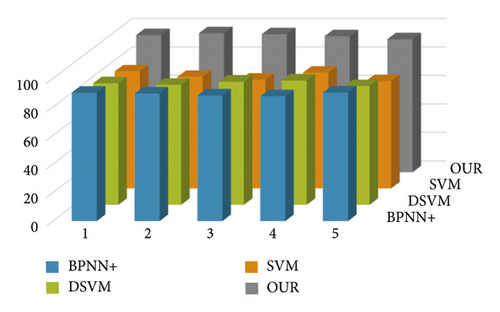
Three methods were used to conduct 10 experiments on 5 sets of datasets. The comparison results of the test time and training time of the four methods are shown in Figures 2 and 3, respectively.
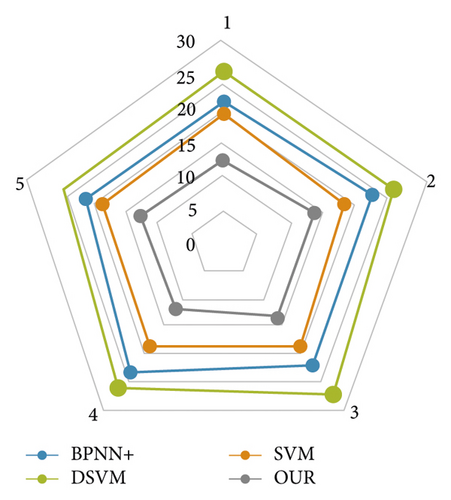
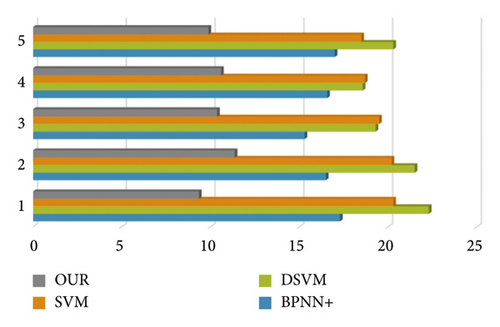
From the comparison results of Figures 2 and 3, it can be seen that the method in this paper has obvious advantages over the other three methods in terms of time efficiency. The training time and testing time of the method in this paper are the least time-consuming, among which the training time is as low as 13 ms and the test time is as low as 9.59 ms. Among the four methods, BPNN+ is the slowest, followed by DSVM. DSVM is better than its improved loss function. Although it can get higher classification accuracy, it increases the running time of the algorithm.
Further, this paper conducts experiments on common UCI classification datasets and selects Iris and Wine datasets for algorithm comparison experiments. The results are shown in Figure 4. It can be seen that the algorithm proposed in this paper is on par with BPNN+, reaching a classification accuracy of more than 95%, which is better than the traditional SVM method and the improved SVM method.
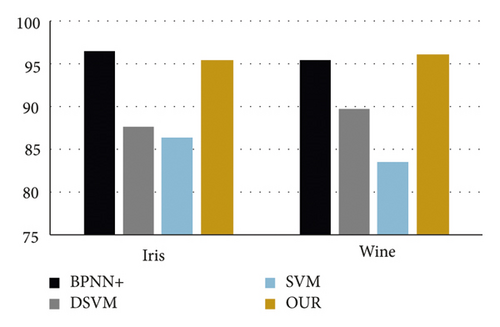
5. Conclusion and Future Work
The education sector now has more prospects for growth because of Internet information technology, which has also sparked innovation in teaching and learning techniques. Among other things, it supported the most effective distribution and utilization of instructional resources. Due to this, a hybrid online-offline teaching approach has been developed that may bridge the gap between the classroom and the outside world, while also boosting the actual learning process and fortifying the relationship between teachers and students. An initial step is to consider how college English teachers can best implement an online/offline mixed teaching mode to ensure that students receive high-quality instructional materials and instruction. Second, support vector machines and particle swarm algorithms are used to develop an evaluation model for the impact of English language instruction on students. Because of the model’s ability to meet the requirements, it is possible to conduct more accurate and efficient evaluations of English teaching effects. In particular, the technique surpasses the comparison algorithm in terms of accuracy and processing time while evaluating collegiate English education.
- (1)
To conduct future research on the effectiveness of college English instruction, a more scientific method of evaluating students’ performance on the evaluation index system will be required.
- (2)
The techniques described in this paper can be applied to assess instruction in other fields.
Conflicts of Interest
The authors declare that they have no conflicts of interest.
Open Research
Data Availability
The data used to support the findings of this study are available from the corresponding author upon request.



